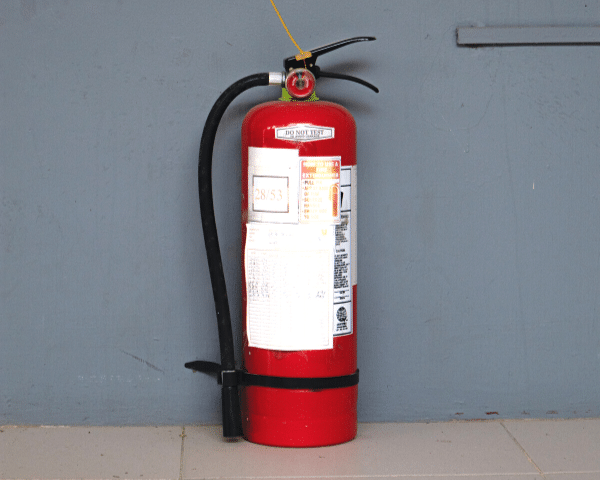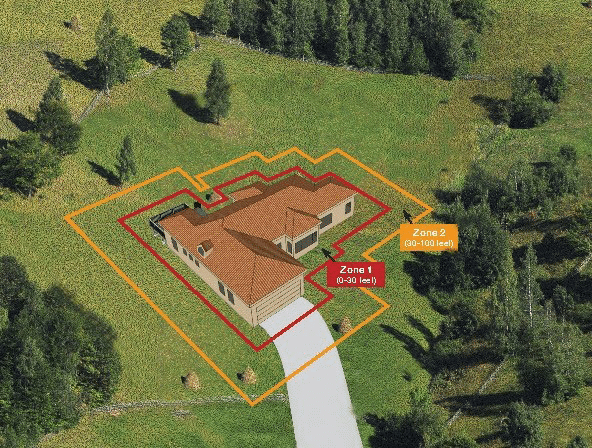
Fire has always been a natural occurrence in California. Our hills and canyons burned periodically long before we built homes here. Many homes have been built and landscaped without fully understanding what a fire can do and few families are adequately prepared for a quick evacuation. Fire officials say that most homes that burn during a wildfire aren’t ignited by dry brush, but instead by embers landing on the roof, through vents, or on decks and porches. Simple fixes from roof to foundation to make your home safer from embers and radiant heat.
Defensible Space Works!
If you live next to a naturally vegetated area, the Wildland Urban Interface, you should provide firefighters with the defensible space they need to protect your home. Create a buffer zone by removing weeds, brush, and other vegetation. This helps keep the fire away from your home and reduces the risk from flying embers.
A home within one mile of a natural area is in the Ember Zone, where wind-driven embers can be a risk to your property. You and your home must be prepared well before a fire occurs. Ember fires can destroy homes or neighborhoods far from the actual front of the wildfire.

Image from San Diego Fire Department
How to make your home fire-resistant
Roofs
The roof can be the most vulnerable because of the large surface area. Roofs made of metal or asphalt are generally safe, as the most dangerous roof type is one made of wood shingles. In California, it is common to have Spanish tile roofs, but this type of roofing is prone to cracks and openings that allow embers to sneak into and start another flame. Check with a local building inspector to see if yours is up to date. Always keep your gutters clean, too – dead leaves are tinder waiting to ignite.
Eaves
Embers can gather under open eaves and ignite combustible material. Enclose your eaves to prevent ember intrusion, and regularly clear away debris that collect here.
Vents
Embers can enter the attic or other concealed spaces and ignite combustible materials. Vents in eaves and cornices are particularly vulnerable, as are any unscreened vents. Use corrosion resistant metal mesh to screen all vents, and check them regularly to remove any debris that collects in front of the screen.
Walls and Fencing
Wood products, such as boards, panels or shingles, and common siding materials are combustible and not good choices for fire-prone areas. Combustible siding or other combustible/overlapping materials provide surfaces or crevices for embers to nestle and ignite. Build or remodel with noncombustible or ignition-resistant materials whenever possible. Regularly clear away debris from any crevices and perform annual upkeep.
Windows and Doors
Embers can enter gaps in doors, including garage doors. Install weather proofing around your garage door, and if your garage is attached to your home make sure the interior door is solid and on self-closing hinges.
Plants or combustible storage near windows can be ignited from embers and generate heat that can break windows and/or melt combustible frames. Wherever possible, use dual-paned windows with tempered glass, as they are less likely to shatter from radiant heat. Repair or replace damaged or loose window screens and any broken windows.
Balconies and Decks
Wooden decks and furniture are especially vulnerable. Build a deck with ignition-resistant materials. They last longer and take less maintenance than wooden ones.
Do not store combustible items underneath them. If there is a fire threat, bring any furniture into your home. Embers can collect in or on combustible surfaces, or beneath decks and balconies, igniting the material and entering the home through walls or windows.
To harden your home even further, consider protecting your homes with a residential fire sprinkler system. In addition to extinguishing a fire started by an ember that enters your home, it also can help protect you and your family year-round from any home fire.
Yard / Garden
Clear vegetation. Combustible materials should be kept at least 5 feet away from walls, paying special attention to mulch which can catch fire and grow. Cut any tree branches within 10 feet of your roof.
Construction materials and the quality of the defensible space surrounding the structure are what increases the chance of survival in a fire. Embers from a wildfire will find the weak spot in your home’s fire protection scheme and can easily catch because of a small, overlooked or seemingly inconsequential factor. Follow these measures so you can safeguard your home, and despite all your efforts, don’t forget to confirm that your insurance is paid and updated with your latest information!
Source: San Diego Fire-Rescue Department




